How to Build a Sales Funnel – B2B Model
Over the past years, we’ve seen more proclamations of a sales funnel death than celebrations of its birthdays. However, it’s still the most common area of improvement for sales and marketing teams. And rest assured, sales funnels will be here for a while (shaking off copious funerals arranged by haters) to provide valuable guidelines to salespeople on how to do their jobs.
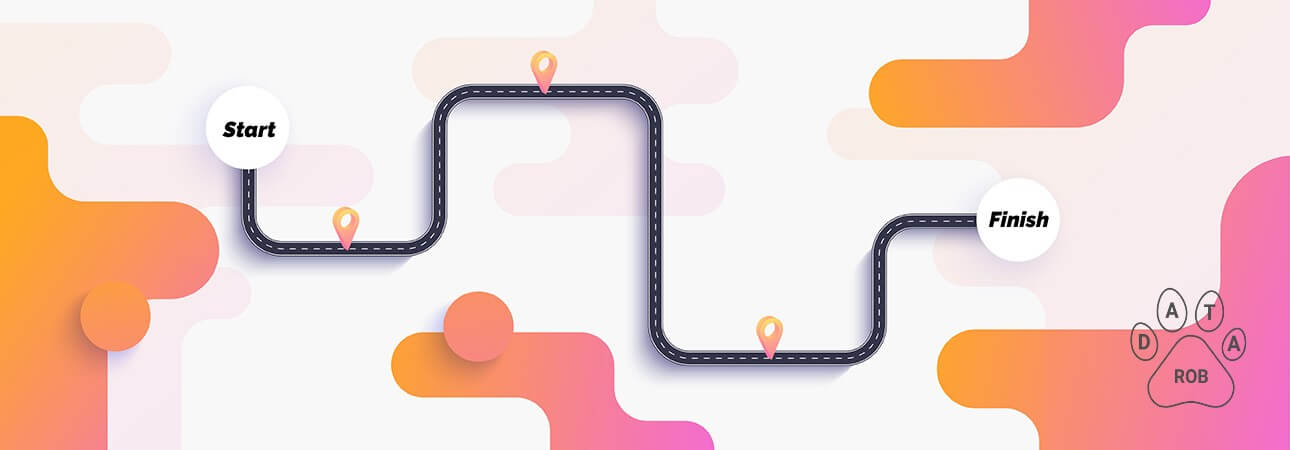
It’s not uncommon for the sales process to be described in orderly, consistent fashion, yet have an actual process look something more like this:
The origins of the sales funnel were developed by the American pioneers of advertisement a century ago. Sales funnels include many different models and come under a variety of names. Customer funnel, sales cycle, purchasing process, and buyers journey are often used interchangeably. Such abundance is due to the application of the term in multiple fields of study as well as the tendency of individuals to “own” specific processes attributed to the sales funnel.
Along with a variety of models, there’s no consensus on what a sales funnel should or should not encompass. Its anything but consistent, from company to company. Marketers see it as a journey a customer takes from awareness to consideration to decision phase about the product or service in question. Same goes for repeat purchase or expansion (loyalty to a brand). Meanwhile, many sales teams perceive it as the specific number of steps performed to turn a prospect into a client.
The purpose of this article is to provide the most comprehensive insight into purchase funnel models– and how to build or modify them for maximum sales effectiveness.

What you will learn about sales funnels:
1. What Is a Sales Funnel?
2. Models of Sales Funnel
- AIDA
- Classic sales funnel
- Forrester’s models
- McKinsey’s Loyalty Loop
- Heinz Marketing’s Bowtie
- Purchase funnel of Marketing Made Simple
- JB Media Group’s sales funnel
- RAIN Group’s buying process
Challenges of Building a Sales Funnel
4. Experts about Sales Funnel
Matt Heinz – President of Heinz Marketing
Carlos Hidalgo – Founder & CEO of VisumCx
5. How to Create a Sales Funnel
What Is a Sales Funnel?
There are three processes that are important for the understanding of a sales funnel:
- buying – seeking for the solution of a problem (pain point);
- selling – searching and communicating with customers that experience a particular pain point in order to provide the solution;
- marketing – studying the problems and those who have them, educating the potential buyers and supporting the sellers.
Sales funnel is where these processes meet and engage. It’s up to a particular organization how it arranges this contact. Obviously, the buying process is beyond your control. However, you can influence it through a manageable selling process and marketing activities.
Why funnel?
On the one hand, the purchase funnel is firmly interwoven with a sales pipeline of a company. The latter represents the scope of your influence on the pool of potential customers. Their number decreases as they pass from one stage to the next one. For example, your SDRs sent 2001 emails in June 2018, got 42 replies and set 14 appointments:
Next, you had 10 prospects who showed up and your sales team won 5 deals. In one year, two customers churn. However, your team manages to expand 1 account and negotiate the reselling for 2 clients. As a result, you have 3 customers in June 2019.
That’s a very simplified math. Obviously, your sales team works hard every month to make sure that there’s plenty of fish in your sales pipeline.
On the other hand, a marketing funnel represents how a customer moves from the general knowledge about the product/service and their providers to a very specific action – the purchase from a certain company. That’s why the top of the funnel is always wide, and the bottom is narrow: of all the offers out there your client finally chooses you.
Controversy
Many experts claim that a sales funnel is a sequence of stages (phases) in a single selling process. A prospect enters the sales funnel by gaining awareness about a product or a service. And afterward, he or she goes down the funnel through the Interest and Decision stages to Action.
However, new researches in 21st century put the old sales funnel model under question. In 2010, Forrester issued several reports dedicated to the subject. They emphasized that the old model didn’t take into account the advocacy of the clients, customer lifecycle, and complex buyer journey.
Furthermore, back in 2012, CEB made a comprehensive research on customer behavior and figured out that many prospects began falling off the classic sales funnel. According to CEB, the buyers did the research on their own and would often enter the sales funnel at the late stages.
Sales Management Association made a conclusion that customers movement along sales funnels changed. It used to be one way – from the top to the bottom. Now, it became multidirectional. In addition to this, the number of channels and touches per one buying process increased significantly, making marketing teams an important part of the process.

Sales Funnel vs. Buyer Journey
Some of the marketers were eager to announce the death of a sales funnel and offered to replace it with the term “a buyer journey“. However, in our opinion, this approach isn’t effective. And here’s why. This term appeared as an acknowledgment of the buyer’s power and control over the buying process.
The sales funnel in the past was pretty stressful for customers as they lacked data and were under constant pressure from sellers. The vendors were active, they were the leaders and controllers of the process. The clients were passive and forcefully guided through the funnel.
There was a strong imbalance in favor of sellers. However, today we see the new imbalance in favor of buyers. Abandoning the idea of a sales funnel strongly supports this situation. However, is it really good that buyers have a full control?
Ric Riddle in his webinar said that customers who do the research on their own often don’t see the root causes and come up with suboptimal solutions. In addition to that, the pressure of decision making process can cause buying analysis paralysis and halt the sales.
There’s one more important aspect about the sales funnel – the internal organization of your sales and marketing efforts. Carlos Hidalgo was one of the few people who defended the sales funnel stating:
In order to manage any change, organizations must address the internal, operational process so that sales can effectively engage with customers
Sales funnel is an inalienable part of the operational process, which inter alia is necessary to build a sustainable strategy for the communication with your potential and existing clients.
And here’s one last argument. No matter how long and complex buyer journey can be, every buyer still moves from a problem recognition to its solution. Vendors pass all the sales funnel stages, even if they get into the same phase two times or more.
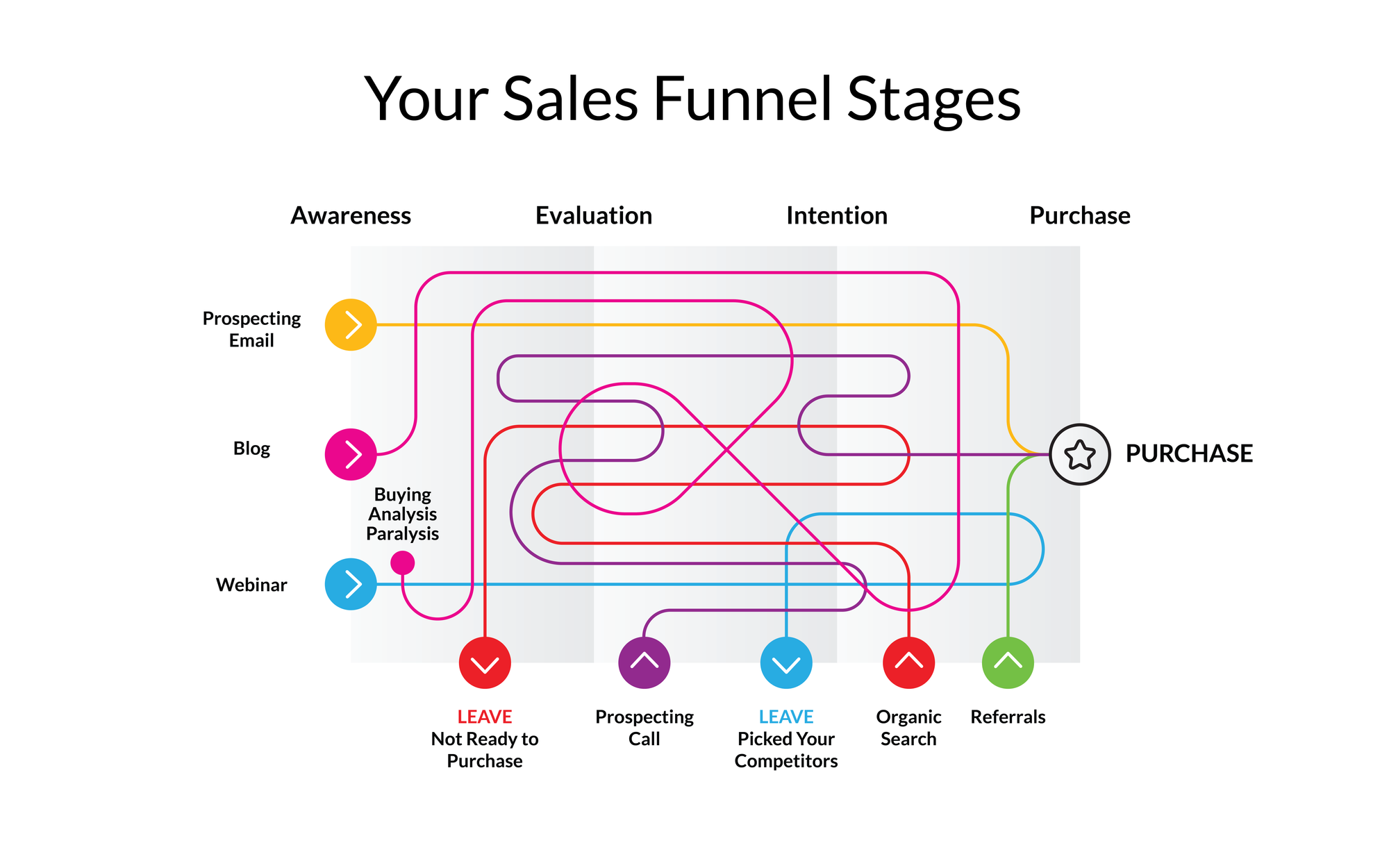
This might seem a chaotic labyrinth. However, try following each of the complex buying journeys and see how it passes the stages of the sales funnel.
By the way, Mark Ritson described the difference between the sales funnel and the buyer journey: If you think the sales funnel is dead, you’ve mistaken tactics for strategy. He used the description of a purchase made by Publishers Clearing House CMO Jason John and explained how it fitted the very first funnel model (AIDA).
What’s more important for a seller is to make sure that every step convinces buyers that this particular solution is the best one on the market for them.

Why are the sales funnel stages so important?
We believe that the sales funnel as a multi-stage process should remain in use, despite the fact that buyers’ journey isn’t necessarily straight and can take any direction.
1. Sales Process and the Pipeline
Any sales team needs an established process. To create it you need to arrange their actions in three dimensions:
- when – phase
- who – position
- what – task.
The stages of the purchase funnel provide you with the landmarks for each dimension.
In the best-case scenario, the real-time visualization of your sales process is your pipeline. It contains all the necessary data about the prospects, opportunities, and clients that you currently work with. A pipeline is a powerful tool to track and analyze the activities of your sales team as well as to make predictions of your revenue.
Just imagine a company that has a simple spreadsheet of contacts they work with sorted by name or date of the last communication. What should be the next step for a sales team with Company A? How close are they to the actual closing? These are just a few of endless tactical questions.
But there are even more important strategic inquiries. For example:
Is our sales team communicating with enough number of companies to generate the revenue our firm expects from us?
Will we close enough deals to meet the quota? What are our predictions for the next quarter? What did we do right (wrong) last month?
If you don’t have a clear structured pipeline you won’t be able to answer these questions. And you won’t manage to build any capable sales process. As a result, you won’t have predictable revenues. Will your business be able to survive? Maybe. Will you grow your revenues? Unlikely.
Where the structure for your pipeline comes from? A sales process arranged in three dimensions (who? when? what?) in accordance with your sales pipeline. Build a good one to organize your sales process accordingly and see how your revenues grow.
2. Sales Specialization
Once you’ve created a process you will see that the tasks at the beginning of your pipeline (top of the funnel) are very unlike and require different skills than those at the end (bottom). If you’re an experienced manager, you will understand that one person can’t be equally efficient at fulfilling all these tasks.
That’s where sales specialization comes in handy. Though introduced not so long ago, it has proven to be a valuable innovation within sales teams. Needless to say that sales specialization follows the logic of the purchasing process and enables to focus on each stage of the funnel.
Thus, Data Enrichment specialists and SDRs work at the early phases of the funnel. Sales managers take over the middle and late stages. If your funnel goes beyond the purchase phase, then you have Customer Success Managers to serve your existing clients.
Summing up, to build a sales pipeline you need inter alia to establish several positions within your team, hire the right people and equip them with the right skills and procedures.
2. Relevant communication
As a potential client undertakes the buyer journey, they seek and obtain information to facilitate their buying decision – in other words, to move to the next phase. They have three main sources:
- sales team
- content provided by the organization via various channels
- reviews of the providers’ clients and unbiased third parties
At each stage of a buying process, a customer needs to receive the data relevant to that stage.
For example, it would be strange if Custom Success Managers asked the clients during the onboarding call if they need lead generation services. Similarly, it wouldn’t be appropriate if our Sales Development Representatives began straightforwardly with pricing in their email outreach instead of asking discovery questions.
For a marketing team that supports the efforts of the sales, it’s equally important to provide all types of content for each stage of the buying process. Here’s a simple example from the blog of our company:
- What’s the Price of a Lead? – The awareness of a problem stage: high costs of in-house SDR team
- Lead Generation Companies (with Companies Comparison Table and ROI calculator) – Discovery stage – the search for a solution
- Case Studies – Negotiation Stage
A well-tailored sales funnel provides guidelines on what information to provide at a certain stage in order to facilitate the movement of a buyer to the next stage.
4. Conversion rates
How to supply the relevant information about your company and product or service that will help your potential buyers to choose you among many other providers? We’d say the perfect formula would be analysis – suggestion – implementation – analysis – calibration – implementation and so on and so forth.
How do you conclude that you’re doing something wrong in your communication with clients or alternatively – not doing enough? Your sales funnel provides you with the solution to this problem.
When your monitor the number of buyers at each stage of the purchase funnel, you can calculate the conversion rates between the phases. You can see where your teams have done brilliant work (and analyze what’s so efficient about it). Alternatively, you can also spot a “bottleneck” for your prospects, and figure out what you can do to fix the weak spot.
Unmistakably, not all of the prospects that get into your sales funnel will stay in it. However, if you see that for instance at some point you have an abrupt reduction of leads, be sure that you need to change the communication with them at that stage.
Buyer Journey – an important lesson to learn
Despite the necessity of the structure provided by a sales funnel, there’s one important thing that sales teams often forget about – Golden Mean. Being too procedural can be as damaging as not being at all.
A good example is cashiers of some supermarkets offering extra services/products or customer support of mobile operators trying to sell you some new solution for the home Internet not even caring to ask if you have a home. It can be really annoying especially when you’re in a great hurry, with a tired toddler or thinking of something more important than buying a present card.
In the example provided above sellers act more like bots than real human beings. And while in some cases, it’s better to replace actual human communication with software interaction, individuals by no means should liken machines.
Sales process should be – to a certain extent – flexible and adaptive to the needs of every buyer. It’s especially important in the age of micro-targeting and customization.
It would be irrational or even deal-ruining to develop a very specific buyer persona, research the leads that fit it perfectly, make a personalized outreach and then ruin everything by offering them undergoing procedures that don’t fit their buying logic.
There are several ways you can address this issue:
1. Don’t be afraid to ask questions to the prospects you work with. For example:
“Will it be relevant if we shared with you success stories of our customer?”
“Many organizations working in your industry apply this software to strengthen the impact of our service. Do you think your company could benefit from it too”
“What is the buying procedure in your company? We do the following steps to facilitate the buying process for our customers, but we want to be 100% YOU-oriented”
2. Ask for RFP – No need to invent the wheel. Your buyers have ready-to-use procedures. All you need is to adapt.
3. Conduct surveys among your existing clients. For example:
“What was the most helpful in our sales process?”
“What negotiation procedures were in your opinion unnecessary?”
“How can we improve the buying experience of our customers?”
4. Analyze your conversion rates at each stage – they might show the stages of the sales process that need improvements.
5. Track the reactions of your buyers. If they’re bored, less concentrated or tense and impatient, you might be doing something wrong. Summing up, anything that doesn’t bring value to your customer will make them experience discomfort during the conversation with the seller. Don’t push – it doesn’t work that way.

So, what is sales funnel after all?
As we mentioned before, there’s no single sales funnel definition. On the one hand, it’s the understanding of how the buying process is organized. On the other hand, it’s the way a vendor company creates the environment for its potential customers to make a purchasing decision.
Summing up, a sales funnel:
- is a virtual place where selling and buying processes meet enhanced by marketing activities
- contains information about the potential customers of a certain company, their consumer buying behavior, and decision making process
- provides a number of channels for buyers to engage with the organization
- has stages that are relevant to the logic of the buying process
- enables different types of engagement at different stages
- educates and brings value to a potential customer
- is adapted to different types of buyer personas
- gives data for the analysis and planning of sales process, and marketing activities
Models of Sales Funnel
There are several models of a sales funnel that were developed over time due to the evolution of the buying process.
The first model – marketing funnel
The very first sales funnel was AIDA. Developed back in late 19th – early 20th century by a number of American marketers and advertisers, it described a formula for a perfect ad. There were several versions, but AIDA associated with Verdi’s opera of the same name gained a foothold. The term was first applied to sales by Arthur Sheldon in 1911.
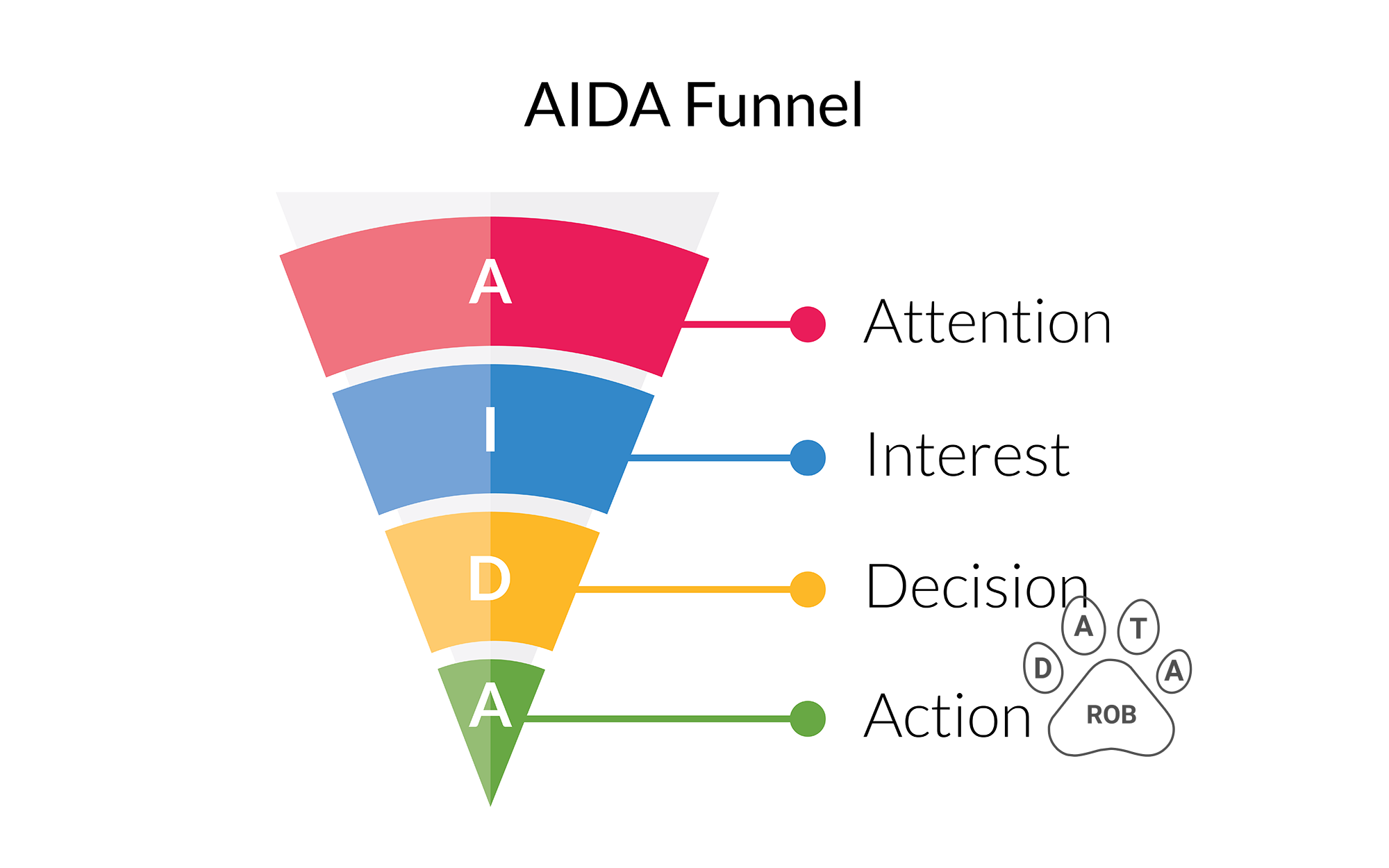
The acronym that stands for Attention, Interest, Desire, and Action was later supplemented by additional stages, e.g. Satisfaction in Arthur Sheldon’s model. Some marketers would rename a certain phase. However, the main idea behind AIDA remains the same:
- First, you notice a product.
- Then you start thinking about it.
- Next, you want it.
- And finally, you acquire it (and experience emotions about it).
AIDA applied to B2B might look like this:
- Awareness – decision-makers find out about a product or service.
- Evaluation – they begin to analyze its pros and cons and compare with similar products/services.
- Intention – choosing the provider.
- Purchase.
We intentionally renamed the stages, because purchases in the B2B environment are driven by rational thinking rather than emotions as opposed to B2C. However, we emphasized that one can’t simply take away sentiments from any human activity. No surprise, that sellers and marketers have always leveraged them.
Pros:
- the purchase funnel was groundbreaking at the time.
- it educates sales and marketing teams on how buyers make their purchasing decisions.
Cons:
- this model doesn’t take into account the emotions, thoughts, and behavior of a buyer after the purchase (except for AIDAS).
Classic sales funnel
AIDA eventually transformed to what Forrester and McKinsey referred to as a classic purchase funnel.
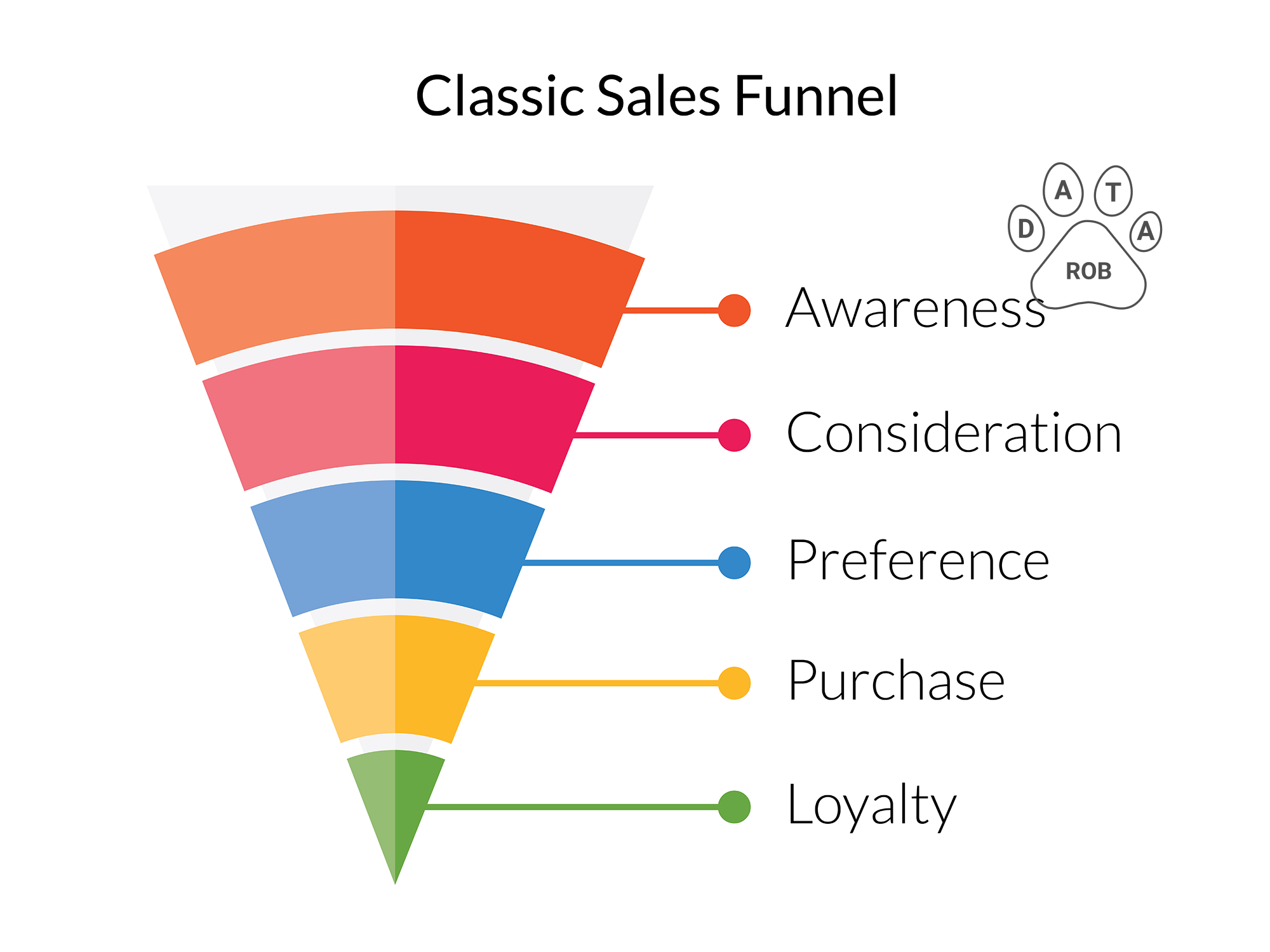
Pros:
- It encompassed loyalty as part of the desired buyer attitude.
Cons:
- It didn’t take into account that on the flipside of loyalty there’s indifference or even hatred.
Forrester’s models
Forrester made several important reports on the marketing funnel. In 2007, Brian Haven’s Marketing’s New Key Metric: Engagement described the complexity of the buyer journey, influenced by information available online. He argued that buyers can become valuable contributors to the brand.
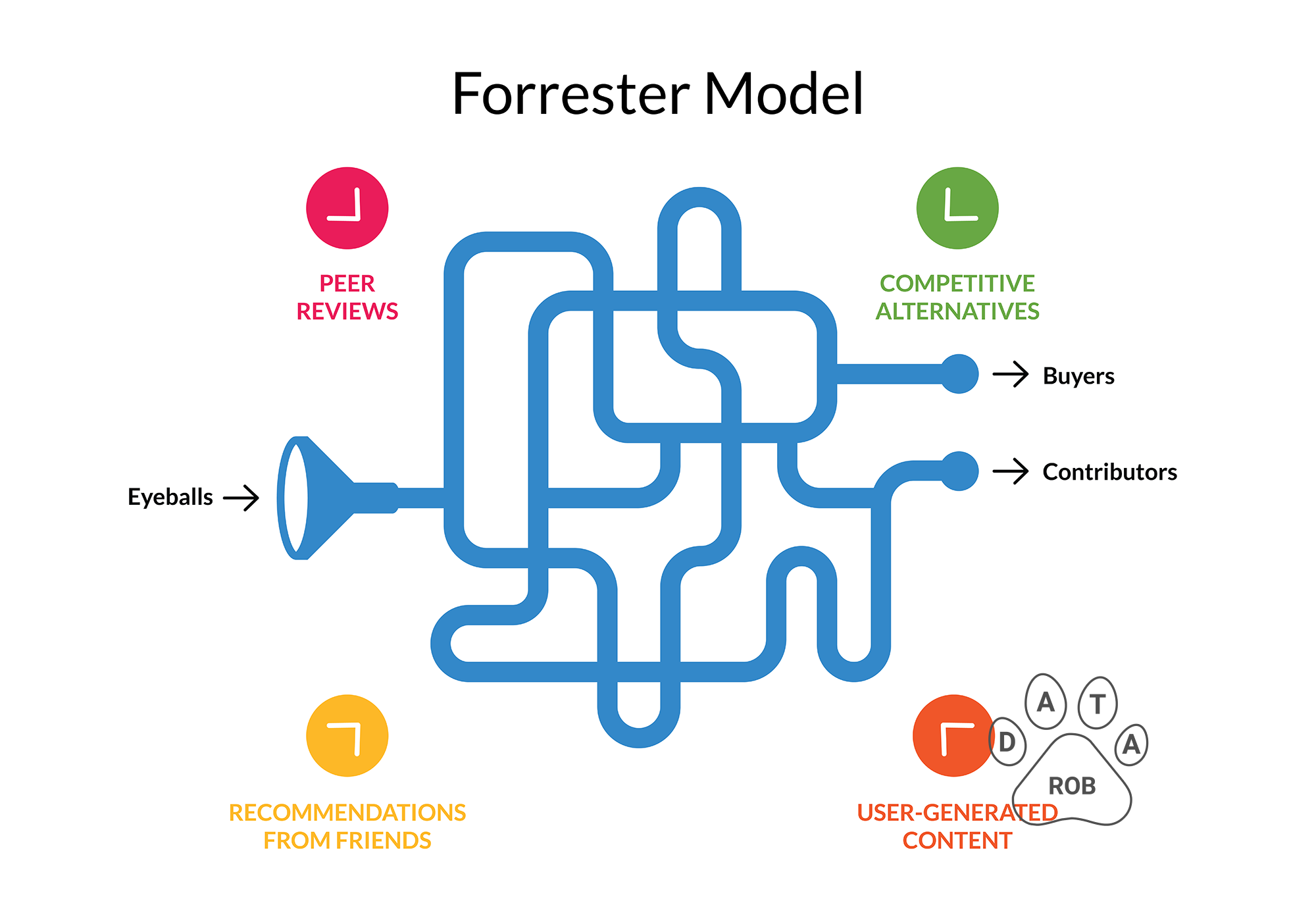
Pros:
- The model shed light on what influence purchaser’s behavior.
- Companies were incentivized to serve their customers better.
Cons:
- The model described a buyer journey rather than a multi-stage sales funnel.As mentioned above, Forrester issued Time To Bury The Marketing Funnel report by Steven Noble in 2010, in which they talked about the customer lifecycle as better ways to understand the buyer behavior.
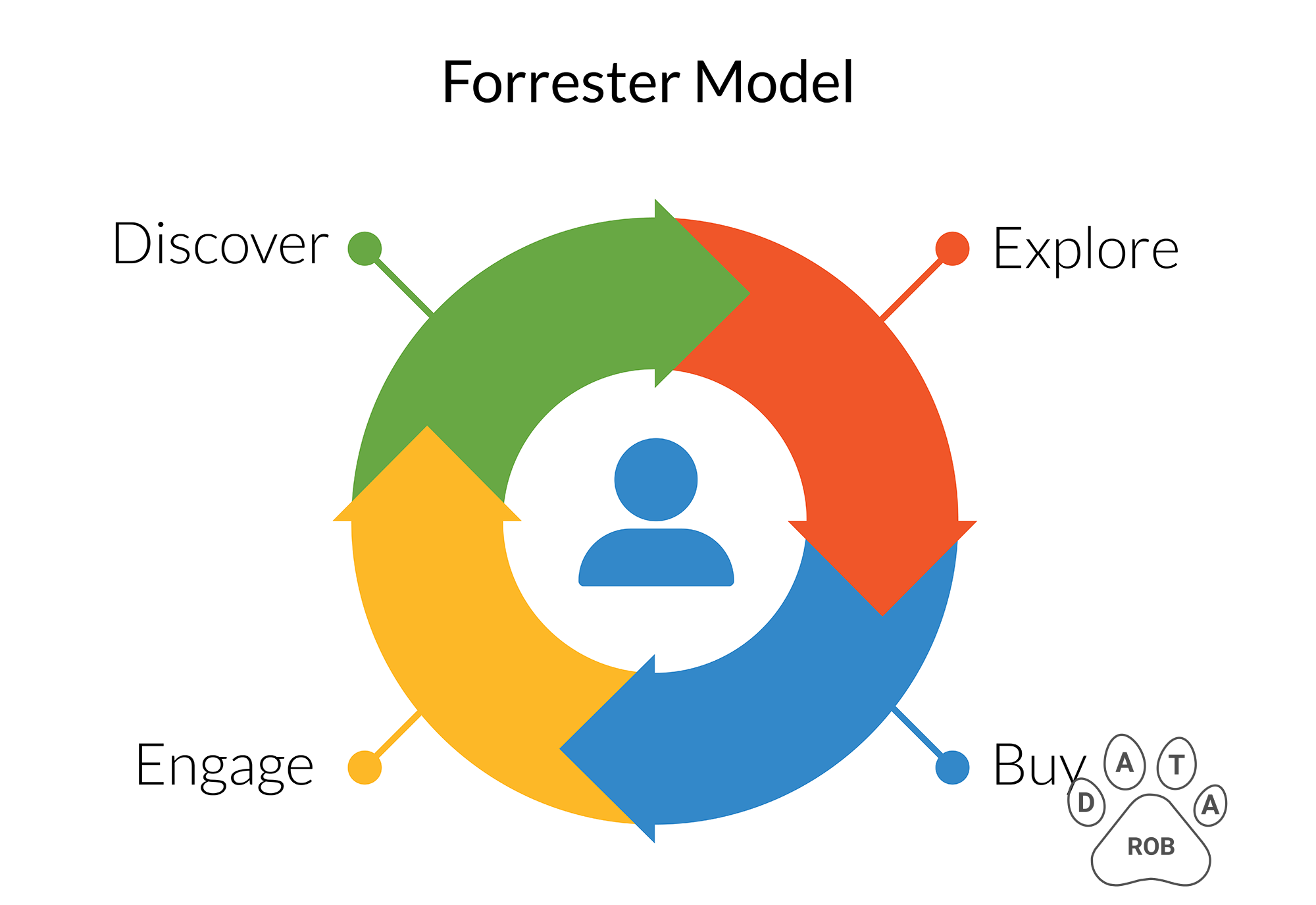
They offered to expand marketing funnel (Awareness, Consideration, Preference, Purchase) and add Loyalty as a next stage. Steven Noble emphasized that such a model will be in line with the customer lifecycle. Discover -> Explore -> Buy -> Engage and back to the beginning.
Later, in 2012 Forrester analyst Jeff Ernst came up with the idea to merge marketing funnel and customer lifecycle.
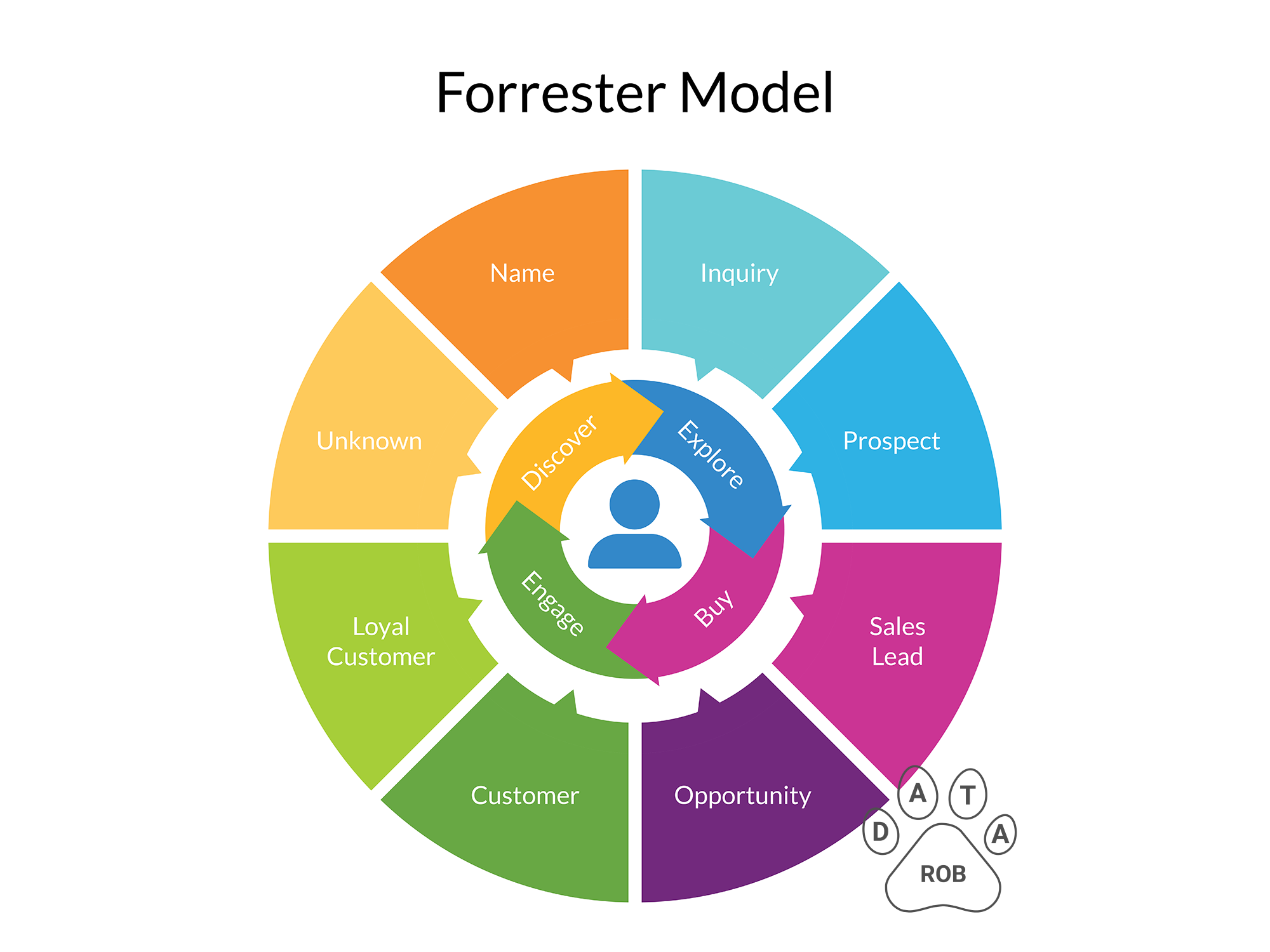
Pros:
- Marketing funnel encompassed the relations of a buyer and a seller after the purchase
Cons:
- It’s only partly true that after the engagement of customers with the brand, they again get into the discovery stage (for account expansion to be precise). In most cases, they either churn or repurchase.
McKinsey’s Loyalty LoopIn 2009, McKinsey presented their model. It was a circle with a loyalty loop, which showed how positive postpurchase experience contributed to the reselling.
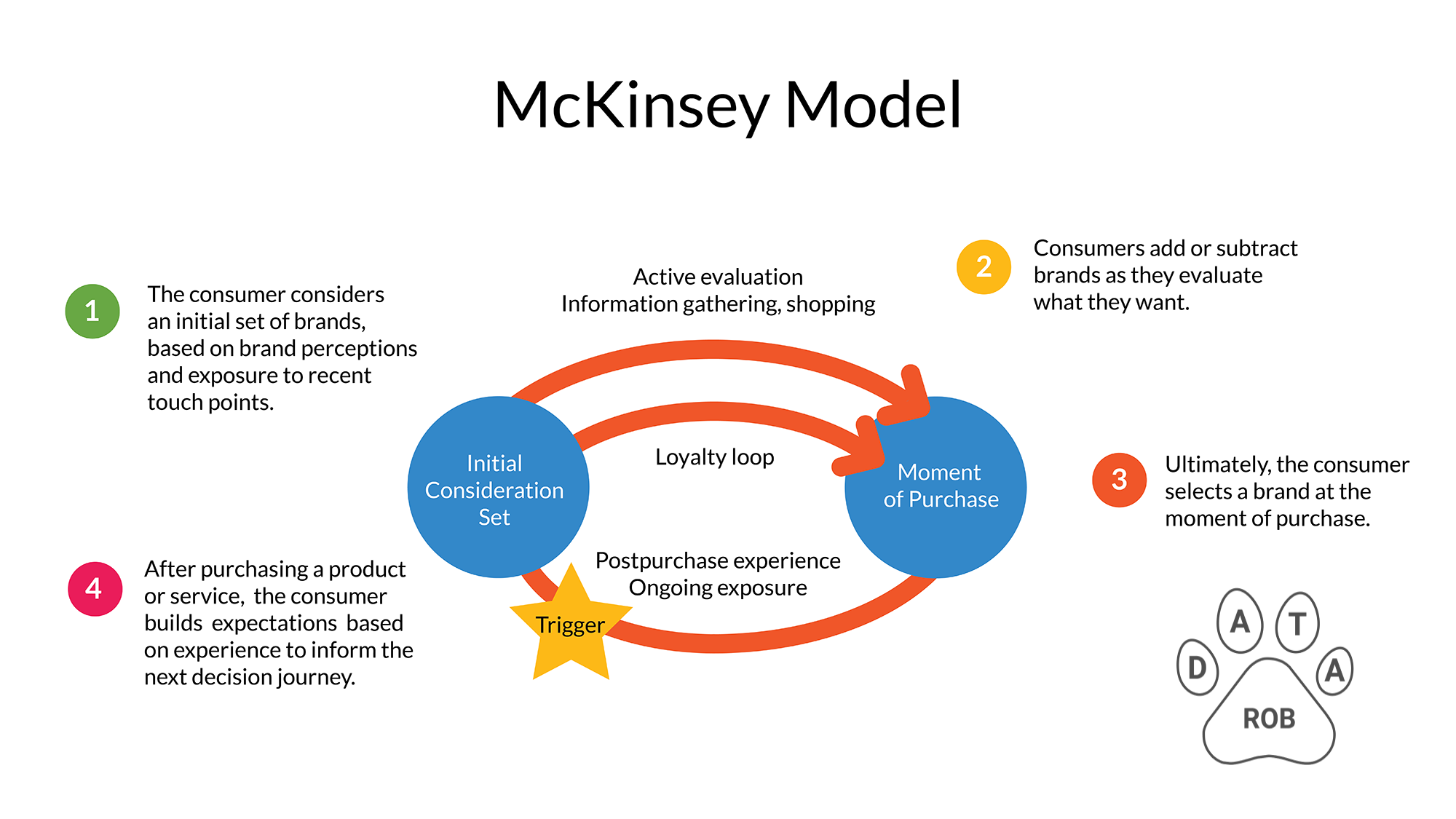
Pros:
- The model encompassed the postpurchase and repurchase stages.
Cons:
- The funnel provided fewer phases.
Heinz Marketing’s – BowtieIn 2010, Heinz made two important statements about classic B2B sales funnel:
- it didn’t take into account the communication with leads that aren’t ready to buy at the time of contact but will be buying in the future
- in reality, it should look like a bowtie, since after purchase there are many ways in which a customer engages with the provider
The model is also called an hourglass – depending on the vertical or horizontal positioning.
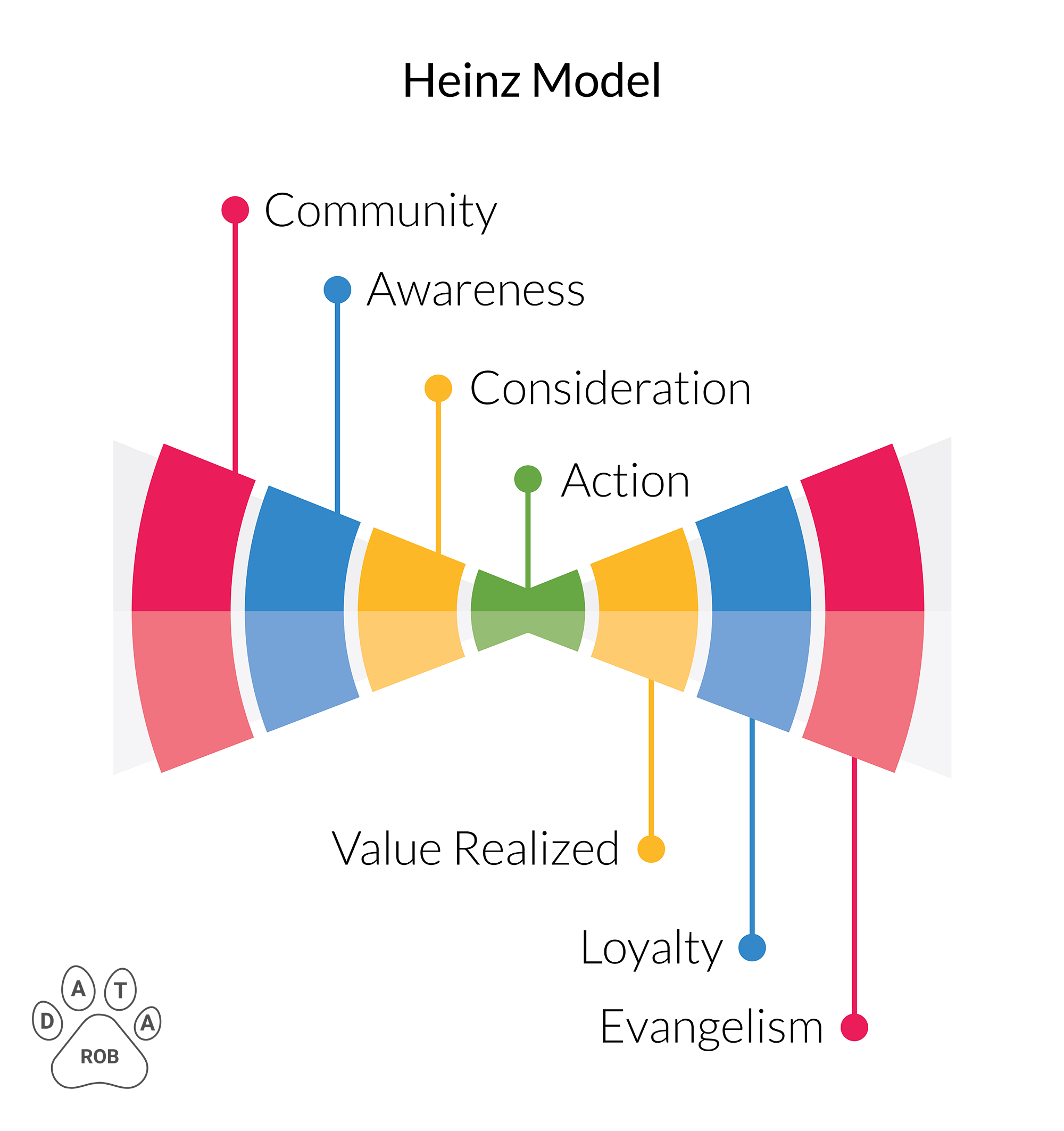
Pros:
- dived deep into the consumer relations with the brand.
Cons:
- didn’t take into account the negative impact of an unsatisfied buyer on the company’s reputation.
Purchase funnel of Marketing Made Simple
In 2017, Jon Gibson decided to share his piece of wisdom in his solo project Marketing Made Simple. He made a short retrospective on the existing models and presented his own version of the purchase funnel. We liked it for a number of reasons, which we’ll list in the pros section.
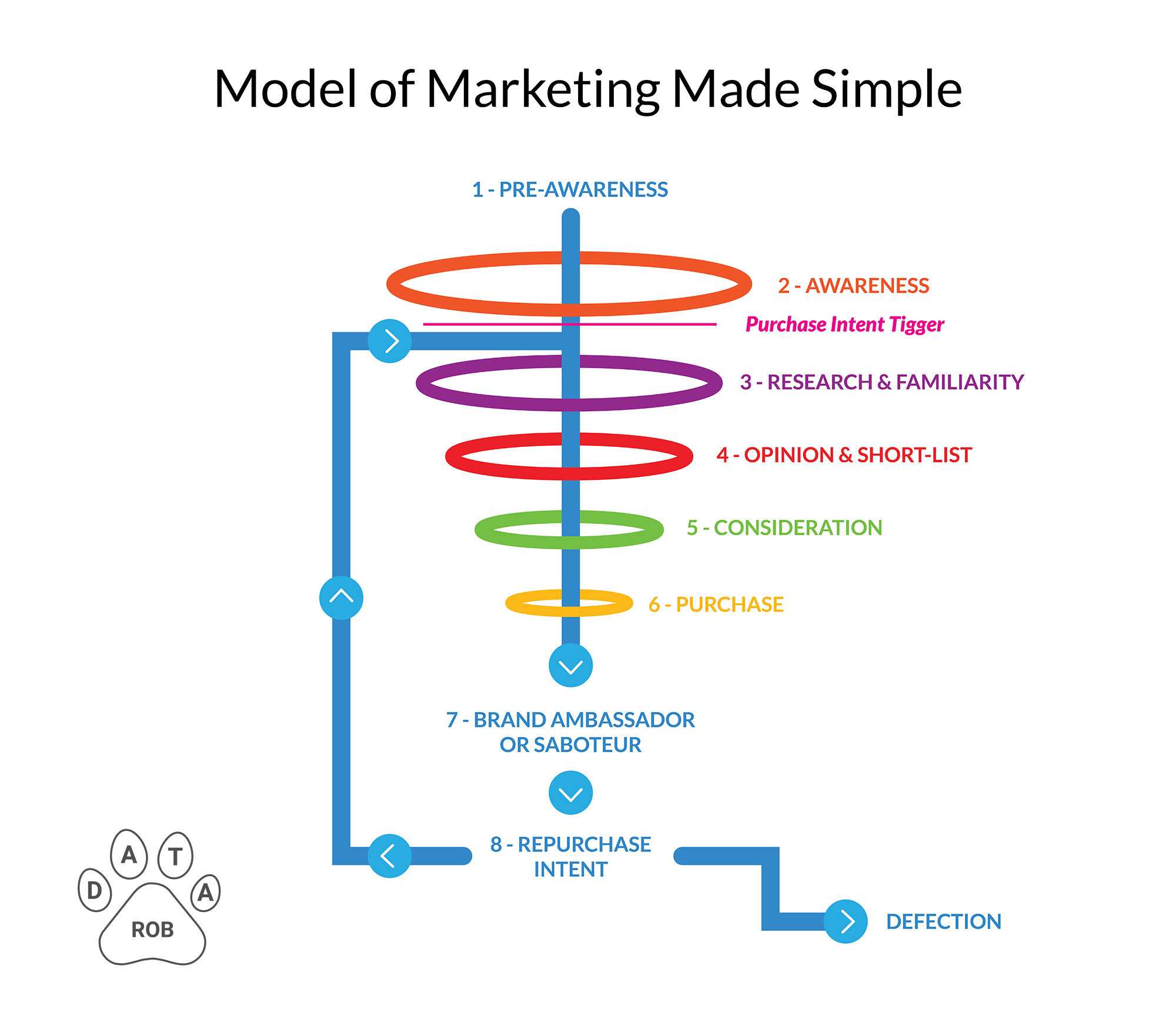
Pros:
- important stages were added: pre-awareness stage, a trigger event, opinion and a shortlist, and repurchase intent;
- defection is also an important part of any sales funnel because it provides valuable data for analysis and planning;
- noted that any buyer can be either ambassador or saboteur of a brand.
Cons:
- account expansion hasn’t been anticipated.
JB Media Group’s sales funnel
The sales funnel was presented by JB Media Group in 2018. See the full model here. The funnel is created for the marketers and explains what types of content are relevant for the potential customer at each phase.
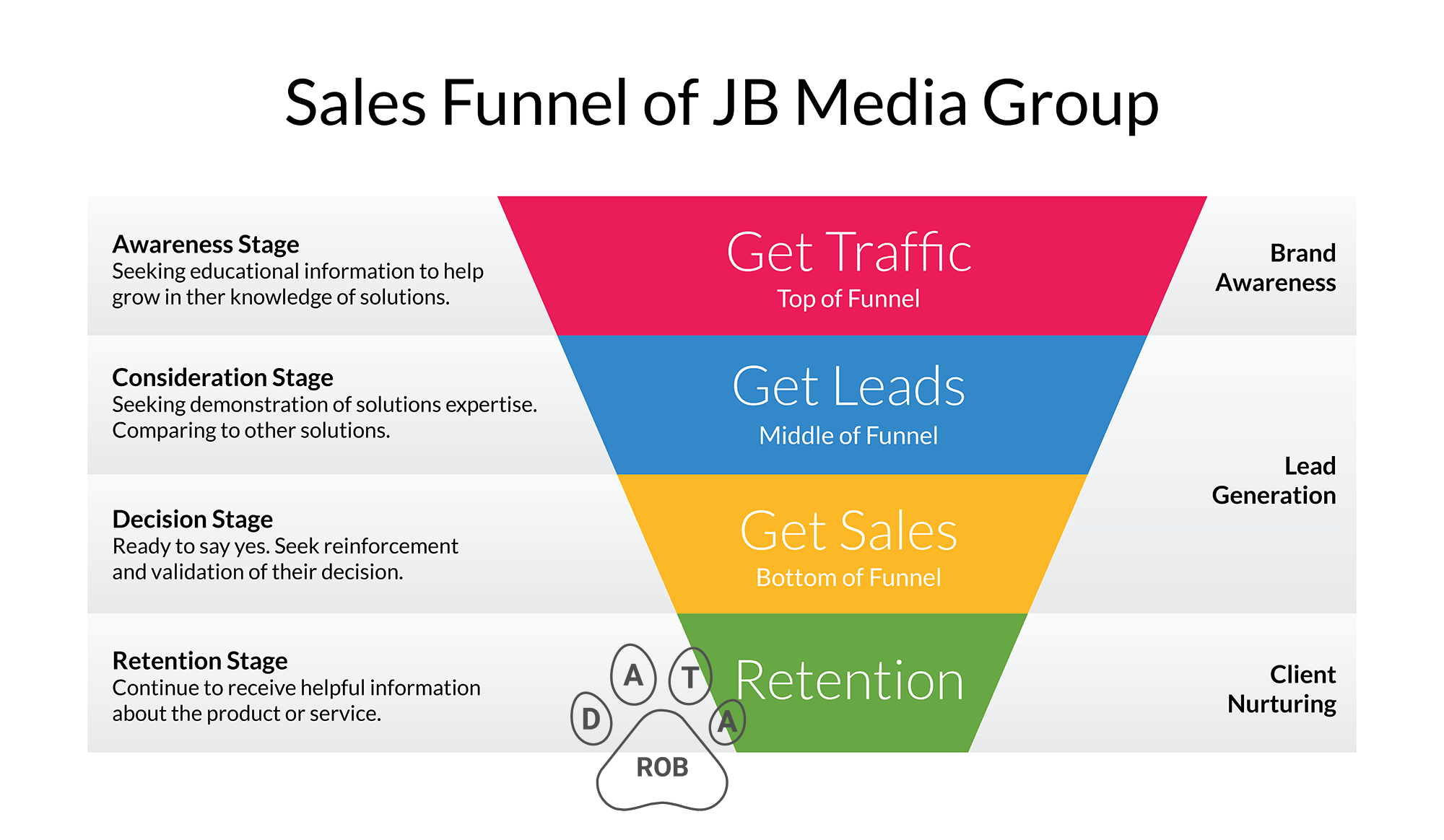
Pros:
- provides guidelines on what to do at every stage of the funnel.
Cons:
- didn’t encompass the efforts of a sales team.
RAIN Group’s buying process
RAIN Group never talked of a sales funnel. Instead, they provided a model of a buying process. See the full model here. What’s interesting in their take is the successful attempt to describe the activities that a sales team should undertake at each stage.

Pros:
- guidelines for the sales team
- the combination of the buying and sales processes
Cons:
- no guidelines for marketers
Challenges of building a Sales Funnel
Sales funnel is a complex construct. However, when it comes to implementation it gets even more complex. In fact, people who have built many sales funnels, state that every single one of them is unique. It should be built in accordance with your company, product, market and buyers.
Here are some challenges companies might face:
Modern B2B buying process and purchasing funnel
What all the models listed above didn’t take into account is the specifics of the modern B2B buying process. We imply the fact that an average purchase in B2B has 6.8 decision-makers on average.
Will it be one sales funnel or many?
For sure, you will have several individual buyer journeys despite the fact that they’re all the representatives of one entity. And you will have to help them deal with their personal hardships of the decision making process. You will have to build an environment that will facilitate their movement from one stage to another.
You will definitely have to take into account all of the buyers involved in the purchasing process as you build your perfect sales funnel.
Old Business
Old companies that have operated for many years now built their purchase funnels decades ago. Some of them haven’t changed the models ever since. They desperately need transformations to adjust to the new realities of the digital era and sales specialization.
However, rebuilding a sales funnel is hard, because it implies changing your sales process. And it’s extremely difficult for several reasons:
1. Sales process = structure
By structure, we mean a number of activities that a sales team undertakes on a daily, weekly, monthly and quarterly basis. Which of them still work? Which are out-of-date? And most importantly – how to change the structure with minimal resources and maximal effectiveness.
2. Sales process = skills
Have you ever played a musical instrument? Those who have, know that learning the wrong consequence of notes is a nightmare. Experts claim that it’s easier to train new skills is easier than retrain the old ones. And a sales team is all about skills. Btw, you’ll need to retrain managers and coaches too (as well as reinvent the training process).
3. Sales process = stability
Stability means you know what to do at each given moment of time. Most people hate changes. Especially, when it comes to the trained skills. They need time and extra effort to get used to it. Many people are biased against new practices and techniques, even if the old ones don’t work. Finally, there’s a natural fear that new tricks won’t work.
4. Sales process = specialists
Someone created that process and trained successors. These experts (mostly managers) know how to support the existing order of things. To create the new process you either need to retrain them or to find and recruit the new ones.
Given the above said, it’s unsurprising, that some established businesses are reluctant to transform their sales funnels. However, being a brand new organization isn’t easier.
Young companies
Start-ups might seem to be in a better situation compared to the old businesses. They can easily learn how to build a sales funnel from the latest blog posts and reports. However, learning doesn’t guarantee successful implementing. Young companies have their own challenges when they decide to establish a sales process.
1. From the Owner to the Sales Department, with love
More often than not, in start-ups, sales are the province of a founder/owner. A talented and ambitious entrepreneur inspired by the novelty of his or her business drives sales with due passion and charisma. Founders use their own networks to generate clients. Once the network has dried up, comes the necessity for new leads.
Simultaneously, the growth f the business requires establishing Sales Department. That’s where the problems might occur. Not all CEOs are experienced salespeople. Oftentimes, they lack expertise on how to build sales funnel, sales process and procedures. Especially when it comes to lead generation, which is still new to many people.
2. Experience
To create a sales funnel means to describe your buyer’s journey, to outline the key touchpoints, to create a working message. Most companies analyze the existing patterns of their buyers’ behavior, their communication, and reactions. Start-ups don’t have this data. Furthermore, such sensitive information isn’t something you can Google.
3. Costs & Time
Building a sales funnel for start-ups from scratch requires hiring and training a sales team. It will take time nd money before they achieve the full productivity.
Solution
One of the possible ways to reduce costs and gain expertise is outsourcing some activities within a sales funnel. As a rule of thumb, companies entrust the top of the funnel to the third party rather than the middle and the bottom. For example, outsourced lead generation services enable to save budget on OTEs and the software as well as managerial time.

Marketing and Sales: versus or plus?
Many companies have seen conflicts between marketing and sales. Who should dominate the funnel? Which team should generate leads? Which techniques are more efficient: inbound or outbound? And probably the hardest tension is MQLs vs. SQLs. In this part of our article, we try to answer these difficult questions.
The buyer journey has heavily digitalized over the past decades with the massive access to the Internet. Everyone loves web for the availability of the information in the first place. You can find almost any data you want and leverage it too. This influenced the way buyers make their purchasing decisions, and thus the way we build our sales funnels.
But…
Has informational abundance made our buying experience easier?
Barely… Now buyers have more control over the buying process (as mentioned above) and thus more responsibilities. As a result, it has become significantly longer and harder for both decision-makers and vendors. Back in the 90s, the key task was to close. Today, it’s to provide as much valuable information as possible.
Let’s take a simple example of content development over the past decade. Back in 2000 and something it was sufficient to staff your website with keywords to get the best place in SERP. In 2018, Googles methods of page ranking are the grey area of assumptions.
The era of meaningless articles with keywords ended long ago. And selling texts don’t work either. One can’t simply publish an article that doesn’t provide new and valuable ideas and hope it will stand out.
The successful sales funnel is a value-rich informational environment that facilitates the buying journey for the decision-makers.
Who creates this value for your product and service? Marketing team in cooperation with Sales. They study the market, competitors, buyer personas, USP. They do the segmenting, think over the four Ps.
Who delivers this value to the prospects? Everyone. In today’s high-competitive environment you need to leverage basically every channel of communication with your potential customers to succeed. Furthermore, their methods of influencing buyers differ by nature. Needless to say – the more methods you have, the better. Just make sure they’re efficient.
Marketers target large audiences and provide reusable information. Sales excel in real-time person-to-person communication.
There’s one more important thing to consider. In the B2B model (unlike B2C), marketers don’t sell. Will you buy a $50 garment from an online store? Probably. Will you enjoy a robot delivering your pizza (yep, no need for tips!). Will you object to using an automated cashier in a supermarket? Hardly. You will probably use a credit card to pay for Grammarly Premium for your team. It’s only $12/mo, but…
Will you sign $200K contract by filling a form on a website without negotiating the terms?
Any B2B sale requires face-to-face communication. And that’s what sales do and marketers don’t. The former negotiate. The latter support with reliable and unbiased information.
If your Marketing Sales and Marketing teams communicate, cooperate and think of driving value in the first place, your company succeeds. If they fight over the funnel, they fail.
Experts about Sales Funnel
We reached out to the experts mentioned in this article and asked them their opinion on a sales funnel.

Matt HeinzPresident and Founder of Heinz MarketingProlific author and nationally recognized, award-winning blogger, Matt is President and Founder of Heinz Marketing with 20 years of marketing, business development and sales experience from a variety of organizations and industries. He is a dynamic speaker, memorable not only for his keen insight and humor, but his actionable and motivating takeaways.
Matt’s career focuses on consistently delivering measurable results with greater sales, revenue growth, product success and customer loyalty. He has helped organizations such as Amazon, Seagate, Morgan Stanley, The Bill & Melinda Gates Foundation and many others create predictable, repeatable sales & marketing engines to fuel growth.
Matt is a repeat winner of Top 50 Most Influential People in Sales Lead Management and Top 50 Sales & Marketing Influencers. Matt renovated his 105 year old historic farmhouse in Kirkland, Washington with his wife, Beth and enjoys it with their three young children, dog, two rabbits, and seven chickens.
How do you come up with the idea of a bowtie sales funnel?
I’m sure someone else came up with it before me, we just were on a whiteboard one day talking about customer lifetime value in addition to just net-new customer acquisition. It’s a reverse funnel in terms of expanding the opportunity you may have with a new customer, earning greater retention, renewals, and upgrades.
Has your vision of a sales funnel changed over the past 8 years?
The sales funnel has never been precise for every single deal, so it’s still a model to be used as a baseline primarily. That said I do think that may companies (ours included) have gotten more precise in how we manage funnel stages across sales and marketing. Where marketing traditionally owned the top of the funnel and sales owned the bottom, today we see more companies split the funnel vertically such that sales & marketing each have a role at more parts of the entire buying process.
What’s new about the sales funnel in 2018?
More companies are running account-based sales and marketing programs which means the funnel is much narrower. You don’t start with the entire addressable market or a bunch of web traffic, you start with a smaller set of high-value targets. The buying process doesn’t necessarily change, but the focus from sellers certainly does in this model.
Can you name 3 pillars of a working sales funnel?
Attention, engagement, and commitment. These are generally the top half of the funnel, but you aren’t going to get many prospects to close if they don’t understand the problem that needs solving and commit to change on its behalf.
Learn more about Heinz Marketing on their website. Connect with Matt Heinz via LinkedIn.

Carlos HidalgoFounder and CEO of VisumCxCarlos Hidalgo is founder and CEO of VisumCx, a Customer Experience Strategy Firm. Carlos has over 20 years’ experience working with B2B organizations in delivering multi-channel customer experience strategies and programs. Carlos is widely recognized for his expertise in B2B marketing, sales, content and demand generation and is an international speaker on how organizations need to transform to meet the needs of their customers and buyers.
Carlos is the author of Driving Demand, has been named one of the 50 Most Influential People in Sales Lead Management for the last six years and is recognized by Onalytica as the “Most Influential Person in B2B North America in 2015.”
1. You were one of the defenders of a sales channel back in 2012 and made some interesting observations in a blog post for ANNUITAS. Has your opinion on it changed over the past years?
I believe what I defended was the use of the funnel internally for tracking and analysis. I think my view on how organizations use the funnel has relatively stayed the same and that is to use it to track and measure your progress toward a revenue goal and the conversion of leads across various internally defined lead stages, but do not make the mistake in thinking that this is how the buyers buy. As I have said many times before, I have yet to hear a B2B buyer ever state “I am in the Sales Accepted Lead stage of my buying process.”
2. What are three important things sales and marketing teams should remember when building a B2B sales funnel?
I believe it is more than just developing a funnel. You have to think about building a holistic program that will align to the buyers purchase path. I speak to many organizations who have a funnel they track or have adopted the waterfall, yet they have nothing coming in other than inquiries.
If you are looking to adopt a funnel/waterfall approach, remember, as I stated earlier that the funnel is not the same as a B2B buyers purchase path. Secondly, the usefulness of the funnel is only as good as to the times you are reviewing and optimizing the performance. Thirdly, this changes if you are moving from volume demand generation to an ABM approach.
3. You spoke about the importance to align your sales process with the buyer journey. How to achieve it?
You have to take the time to speak to your buyers and get an understanding of their approach and process of purchasing. Too many organizations do this internally with marketing and sales in a room and never involve the buyers in the mapping of the journey. Often times when I have compared what buyers tell me about their purchase path with what companies think they know; they are very different. It is imperative to get your customers perspective when understanding the journey
4. In your opinion, what’s the best way to build sales and marketing activities for a model sales funnel?
Again, this begins with your buyers and understanding you need to develop a program that aligns to the full journey and not just part of it. Too many times I see organizations doing activities focused on one area of the journey and across just one channel.
B2B buyers are multi-channel in their approach to buying and marketing teams have to know what channels their buyers prefer before they begin launching activities and sending out content.
So the answer is . . . it depends. The most useful activities will depend on what your buyers prefer.
Learn more about VisumCX on their website. Connect with Carlos on Twitter.
How to create a sales funnel
Building a sales funnel is a challenging task for any organization. It needs efforts from both marketing and sales teams. There are two main aspects you need to remember:
Customization wins and it’s an ongoing process
Just like you outline your buyer personas, to make your outreach personal, you need to adjust sales process to the needs of potential customers. No model you’ll ever find on the Internet can provide a comprehensive guide on how to build a sales funnel – that is to say the efficient communication environment between your company and your buyer.
What works great in the financial sector, might fail in the automobile industry. For example, demonstrations are good for tangible products or software. However, case studies are arguably better for service providers.
Here’s another good example. Databox has applied a unique lead generation tactics for their company. Read the interview with their CEO Peter Caputa to learn more.
No matter what sales funnel model you apply to your process, you need to customize the activities at each stage to create the best buyer experience and give your customers what they need to move forward.
The task of your marketing and sales team is to study the behaviors of your buyers all the time and adjust their tasks to it. Obviously, it can’t happen overnight. Continuous monitoring and analysis can provide you with valuable data and unexpected insights.
So, make sure that your selling process is flexible to a certain extent. In this case, any strategical or tactical changes in your sales funnel will require fewer resources (time, money, efforts) when implemented in real life.
Problem-solving is a new evergreen black
What could possibly blues, Marvel movies (well, pretty much almost all the human culture), and B2B sales process have in common? They’re built around one single pattern:
The Question (problem) – The Answer (solution)
That’s because of who we, humans really are. We are problem-oriented creatures. Our brain shows stronger reactions to negative stimuli than to positive (and obviously the neutral ones). That’s called negativity bias. That’s why many of us love hero stories with their thrilling global threats.
Obviously, the behavioral reactions of individuals vary on a scale from stagnation to thinking to action. However, your prospects are most-likely those who take responsibility and act. Otherwise, they won’t be managers and C-level titles.
The resolution of problems takes almost as powerful effect on our brain. In a sense, it can be regarded as a reward, which is closely linked with pleasure. Catch your buyer’s attention by speaking explicitly and fairly about their pain points. Then teach them how to solve it and leverage effect.
Summing up, build your funnel around problem-solving. This means every stage and every activity should empower your buyers with the knowledge they couldn’t get elsewhere. If you do it right, it will help build trust between you and your potential customer and eventually influence the purchasing decision.

Build your own sales funnel
We suggest creating a spreadsheet that will cover the following aspects:
- Purchase funnel stages
- Substages relevant to your product and industry
- Sales activities at each stage:
- Tasks
- Sales staff responsible for each particular task
- Software & tools you will need at this stage
- Key skills required and Training
- Marketing activities at each stage:
- Tasks
- Marketing staff responsible for each particular task
- Software & tools
- Key skills required and Training
- Outsourcing options
- Conversion rates at each stage
- Activities aimed to stay in touch with the prospects that aren’t ready to make a decision
- Analysis:
- Key strengths and weaknesses
- Forecasts
- Suggestions on how to adjust a stage to address the buyer’s need
Funnel icon
Funnel icon or sales funnel icon (png)

Datarob Sales Funnel Model
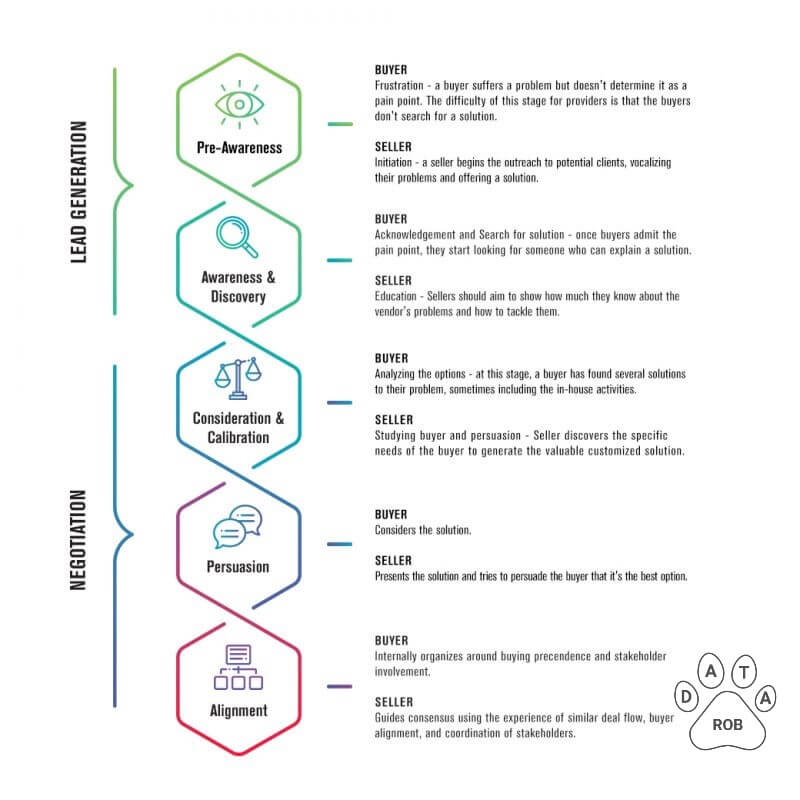
Preview of Datarob sales funnel model
At the Top of a Sales Funnel – Lead Generation
As a lead generation company, we understand the importance of the top of the purchasing funnel. If you don’t get enough high-quality leads, the whole sales process will collapse no matter how perfect your later phases are.
Lead generation is a complex process that for sales teams comprises of two stages:
1. Data generation and enrichment – the acquisition of the accurate contact data of the leads that fit your buyer persona
2. Outbound Prospecting – connecting with your leads with a view to find out more about their pain points, educate them on how to solve their problems, offering to start a conversation with your sales managers.
These practices can be quite expensive. That’s why many organizations are eager to reduce the costs by working with lead generation companies.

